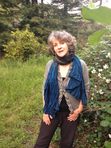Patricia Damery's Blog, page 14
February 17, 2015
Liminality… and Hope
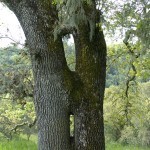
Entering the mystery
Liminality is a word that people ask me to repeat twice when I say it, as if they didn’t hear it quite right the first time. As a Jungian analyst, I recognize the liminal state as that of many entering treatment. The old way no longer works, but the new hasn’t materialized. Our Western-European culture has trouble with the liminal, not wanting to suffer the disorientation or discomfort. We often want to return to the old way by denying anything has occurred. Sometimes we often think we just need to “adjust” and everything will be okay. Too often we are supported in medicating ourselves with pharmaceutical drugs— or with the more recreational varieties to this end—and miss the real soul opportunity.
The word liminal derives from the Latin limen, Limin-, threshold. Anthropologist Victor Turner described liminality as being the middle stage of a rite of passage ceremony in which the initiate is no longer of the old structure but the new has not yet come. Carl Jung offered a great deal in holding the tension of the liminal. Opposite feelings are recognized and suffered, even though this is intensely uncomfortable. If we are able to do this long enough and with enough consciousness, a new state may arrive that is something entirely different. This is the process of what Jung termed the transcendent function and it has an age old tradition in alchemy.
When people come into psychotherapy in such a threshold state, I often tell them of a story I read in which Columbus turned his ship around twice in his explorations of the New World simply because he did not want to confront the implications of what such a discovery meant. Threshold experiences are hard! The maps of our world change! But we become larger and more whole if we can allow ourselves to take it in.
Confronting Climate Change is a collective liminal experience with huge dimensions. Sailing back to the Old Word, expecting that temperatures and conditions will return to the old normal, or feeling that it doesn’t matter what we do, it is out of our control… all of these are defenses to tolerating the excruciating liminal space of climate change. There are no promises of where it will lead, if humankind can remain on our planet. But following the pattern of the liminal archetype, tolerating the uncertainty, which also means keeping our eyes open to the changes, and to our own part in these changes, to our fears and our grief, all of this is our only hope of some new order which may include humans on our dear Planet Earth.
This does mean getting to know others who are willing to suffer the knowledge of the present. For me, doing something helps, and this has meant activism around preservation of the oak woodlands and implied watershed of the ridge I live on. I also have found several books which offer ways of tolerating what seems intolerable. Mary Pipher’s book, The Green Boat: Reviving Ourselves in Our Capsized Culture, is one such book. Others include Marko Pogacnik’s Gaia’s Quantum Leap: a Guide to Living Through the Coming Earth Changes, and Dennis Klocek’s Sacred Agriculture: The Alchemy of Biodynamics. The important thing is to develop your liminal community, not just sit alone with your fears and grief. Join others who are willing to stay conscious in this time that needs us so much. In the serpentine way of suffering, this community with like minds is also our hope of dreaming in that new structure that may support life on this planet for even us.
The post Liminality… and Hope appeared first on Patricia Damery.
February 9, 2015
On Ecological Sustainability: Judith Parrish, Plant Ecologist
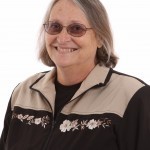 My first interview on ecological sustainability is with my sister Judy Damery Parrish, Chair of the Biology Department at Millikin University in Decatur, Illinois. She is a passionate teacher who loves the earth with fierceness, reflected in here.
My first interview on ecological sustainability is with my sister Judy Damery Parrish, Chair of the Biology Department at Millikin University in Decatur, Illinois. She is a passionate teacher who loves the earth with fierceness, reflected in here.
What is your background and how did you come to ecology?
I grew up on a farm and spent many hours of my childhood observing organisms in their environments, often lying facedown in the grass watching tiny insects and other organisms make their living. I majored in both zoology and botany as an undergrad at Eastern Illinois University, where field experiences were strongly valued and included in the program. My professors would take students to a field station each spring, each teaching his or her specialty as we spent the morning watching birds, the afternoon seining for fish in a clear stream or sampling trees, and the evening mucking through a swamp triangulating singing frogs with our flashlights. I came to love studying ecological relationships in natural systems, and earned a PhD in Plant Ecology at the University of Illinois. The many different ways organisms cope with challenges of the environment has always tantalized me to examine adaptations and relationships among organisms.
How do you define and/or measure sustainability?
I define sustainability in ecological time rather than geological time. Environments change over geological time due to factors such as continental drift and glacial advances and retreats, resulting in different selective factors on the organisms that inhabit them and changes in adaptations. While there are fluctuations in the environment in a shorter, ecological time scale, sustainable systems support organisms that can replace themselves in the environment for generations. There may be changes in relative numbers in the populations composing the system, but their identities should not change. There should be a dynamic balance that prevents any one species from domination.
What ecosystems that you have studied? Which are of particular interest to you?
Research in tallgrass prairies of the Midwest; interest in South African fynbos and African savannas
Urban ecosystems are of particular interest – I think we can do much better!
What elements are present in those which are “sustainable”?
High diversity both of species and genes within each species. The system should not “leak” resources – there should be very little waste. Some organism will be present to use the resources and keep them within the system.
Are there practices that you have advocated to support sustainability?
Education – as Baba Dioum states, “In the end, we will conserve only what we love, we will love only what we understand, we will understand only what we are taught.” We need to get students away from remotes and cell phones and help them experience and understand – and therefore value – natural systems. David Suzuki states that “our ancient understanding of the exquisite interconnectivity of all life has been shattered.”
We need to preserve what natural systems we can, and we need to provide corridors between habitat patches to allow movement between them, and use polyculture in agriculture to reduce “mining” of the soil. We also need to switch to renewable energy sources and develop local food supplies.
What does a healthy ecosystem look like?
A system that has multiple species at each trophic level, and populations of all age classes. I do think it is possible for human dominated systems to be much more healthy and sustainable, using renewable energy and incorporating green spaces on rooftops, drainage areas, and parks.
What are the forces you see that make ecosystems non-sustainable?
Overuse, overharvesting of any component of the system; removal of top predators, habitat destruction that affects natural reproduction and genetic diversity
What is your hope?
Our hope for sustainable life not only requires for us to understand the natural healing processes of the earth, but also to rediscover that we are an integral part of them. Wangari Maathai, in her acceptance speech for the Nobel Peace Prize in 2004, said “Today we are faced with a challenge that calls for a shift in our thinking, so that humanity stops threatening its life-support system…We are called to assist the Earth to heal her wounds, and in the process heal our own – indeed, to embrace the whole creation in all its diversity, beauty, and wonder. This will happen if we see the need to revive our sense of belonging to a larger family of life.” I am privileged to have a platform in my teaching that gives me a chance to share the importance of discovering our place in nature with my students. I pray that we will learn to value our biological wealth before it is too degraded to heal.
The post On Ecological Sustainability: Judith Parrish, Plant Ecologist appeared first on Patricia Damery.
February 2, 2015
Russian River: All Rivers

The Russian River is a great, lazy serpent in the summer. Her lovely green body curves through redwoods and vineyards, through open meadows and old tourist resorts, on her way to Jenner and the Pacific. I raised my sons well into their elementary years on that river. We learned her many moods: her rushing insistence in the winter which we could hear even as we drifted to sleep; the way she took the town, flooding homes and businesses alike, when the rains went on for too long.
One of my worst experiences with her happened the summer I took my sons, aged 2 1/2 and 7 months, swimming at the quiet beach that used to be Ginger’s Resort. We sat in the shallow water and played. And then we learned that Santa Rosa had another “accidental” spill of sewage and we were sitting in it.
It was during this time that a masked local business man, affectionately known as Manure Man, took his tractor and manure spreader to Santa Rosa and spread manure around the courthouse, saying, “If it’s good enough for Guerneville, it is good enough for Santa Rosa!” I remember a picture in the Press Democrat of a Santa Rosa city official drinking a glass of treated water from the sewage treatment plant, showing how safe it was. These were war days, and they are some of the inspiration of my novel, Goatsong. It seemed to be a battle of those downstream from those further up, so dramatically played out. Sewage spills upstream contaminated our wells for days after.It was really a coming into consciousness of how much we impact each other.
Recently I saw the documentary, Russian River: All Rivers: the Value of an American Watershed. It is gripping in its scope (this is not just the Russian River, folks! it’s all rivers! If we keep up our ignorance of how we manage water, watersheds, and rivers, we are going to be out of water!) It also is a wake up call: there is still something to be done. This needs to not be a battle, but rather a coming awake to the impact of our actions and a gathering of all sides to protect the commons: our land, our watersheds, our rivers, our air. This is not about property rights, right to farm, profit, individual entitlements: it is about survival.
The documentary has several screenings, including a March 4 screening at the Cameo theater in St. Helena. Although there is no charge, there is a request for a donation at the door. You do need to make a reservation, however, as there is always a full house.
The post Russian River: All Rivers appeared first on Patricia Damery.
January 24, 2015
In Search of a Land Ethic: The Grand Coalition
On Tuesday afternoon, January 20, 2015, The Grand Coalition of Napa County met. Fifty of us sat around a square assemblage of tables representing ten citizen groups who have been addressing land use issues in Napa County over these last years. Some have formed non-profits which hired experts and attorneys to address some of the developing problems of incursion of vineyards and wineries into the oak woodlands and forests. Others have worked over years to preserve the natural environment. Many of us are advocating clear standards to keep the Ag Preserve for agriculture, and not for so-called commercial “event centers” with hundreds of visitors at all hours of day and night.
As we sat around the table, reps from each group gave a brief account of their interests and actions. We worked to find common ground upon which to go forward. Seasoned land use advocates, including past members of the Board of Supervisors, imparted their wisdom: We must be fact based. Do not presume the other side, whichever that side is, is the enemy!
The high energy in the room coalesced into forming a steering committee. A member from each group will meet next week to make a mission statement and define a doable agenda. All of us agreed about the importance of attending Board of Supervisors and Planning Commission Meetings as often as possible. About picketing projects that degrade the environment. About making ourselves known as citizens of Napa County who stand for preserving the natural beauty and health of our ecosystems.
There are, of course, demons we can each recognize within ourselves. We live in a culture where productivity and growth are seen as the gold standard. Where beauty is to be exploited for profit. Where the rich have been able to strong arm decisions about land use under the guise of property rights, regardless of the impact on the environment and future generations.
Find common ground, the seasoned member chastened. Do not make enemies here. The other side is not your enemy.
The enemy is really within and confronting him or her requires confronting she or he who makes bargains with the devil: after all, if we cut back on building in the hillsides to protect the ecosystems, we risk hurting the tourist economy of our Napa Valley—and so on.
But there is common ground, and we all share it— a common ground that is becoming more obvious under the pressure of the severe drought: that of the watersheds. Without healthy watersheds, we are doomed. Our water supplies will suffer, along with the native plants and animals dependent on springs, creeks, and rivers. Our best agenda is to learn to tend those arteries of life which sustain us, regardless of the sacrifices.
In the next weeks I will explore this issue of sustainability, interviewing several ecologists, farmers, and government officials as to their own ideas of what is a sustainable environment. It is an idea that has been hijacked by corporate interests, and yet, it is a principle we need to examine without personal bias and intention. And please share your own ideas about watersheds, land use, and sustainability.
The post In Search of a Land Ethic: The Grand Coalition appeared first on Patricia Damery.
January 5, 2015
Dark Gift of Watershed Issues
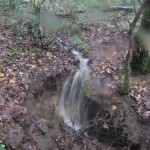
Water on its way to Dry Creek and Napa River.
If life were a current, we have reached a rapids on land use issues in the Napa Valley. As above, so below: how to view these outer issues in a “so below”, inner context? These issues are also a microcosm of what is happening on our earth. Perhaps the dark gift of these times is the urgency to enter the arena of what impacts us so intimately and struggle with what we tend to polarize. (We have gotten a very clear picture in Congress with how effective polarization is in getting anything done!)
Land use issues are watershed issues in the Napa Valley, at least when it comes to the incursion of residences, vineyards, and wineries into our hillsides and forests. Watersheds are something many of us have been unconscious of, and yet, they are the bloodstreams of the county, and of the state, and of the earth. Like a good mother, they are so large and effective they are invisible until they are depleted and not working. Their maintenance is critical to the health of the ecology they are part of.
It is so easy to want to polarize and demonize the other side, regardless of which side you are on. And yet, watersheds are our common ground and they are uncompromising! They remind us we are of one piece. If we exploit them through ignorance and/or greed, through deforestation for vineyards and homes, and by ignoring the importance of riparian corridors which replenish ground water, we do so at our own peril. Rich or poor, we all need water.
Facing the importance of watersheds means developing a respect for the needs of watersheds— and of water. It means caring about the earth, being sensitive to soils and creeks, being open to viewing oneself as only a part of a community that includes soils and creeks, oak woodlands and fir forests. It goes beyond the idea of stewardship, which is really only a kinder version of “dominion over”. We need to be in relationship with our lands, and all that resides there. This requires a consciousness that is receptive to even the sentience of water and nature.
In November I attended a Future First conference in Minneapolis which drew up a Bill of Rights for water. The link will take you to the result, which is well worth reading. Yes, it is a new paradigm (to use that overused word!), but it is the consciousness that may allow us to partner with nature to survive on our planet. It is the consciousness often needed when people come into analysis in later years, and ego stances no longer work. It is time then to listen to Self, to that which is larger and interconnected with the whole web of life. We need to develop this capacity to listen and to feel ourselves in that web, and to learn to serve it.
That is, perhaps, the dark gift in these watershed issues.
The post Dark Gift of Watershed Issues appeared first on Patricia Damery.
December 10, 2014
Trauma, Chaos, and the Psycho-spiritual task of our Time
Is it possible our psycho-spiritual task of this time is to develop the fortitude to tolerate chaos long enough that we are able to birth something entirely new? Are we in a spiritual pregnancy, of sorts, and birth is imminent?
This process is in the collective. Like a supersaturated solution, suddenly crystals form in so many disciplines! A new consciousness is developing, one that is more heart-centered, that humanizes what we analysts call primitive affects, and particularly rage and shame.
On Saturday I attended a seminar that was jointly put on by the C. G. Jung Institute of San Francisco and the Psychotherapy Institute of Berkeley. Jungian analyst Donald Kalsched discussed trauma and development (his latest book:Trauma and the Soul: A Psycho-spiritual Approach to Human Development and Its Interruption). This topic is critically important for each of us to understand within ourselves, as what we are experiencing and will experience in the period we are entering of climate collapse is traumatic. Our defenses of denial and narcissistic entitlement render us useless to do anything.
Kalsched asserted that trauma occurs when we are given more to experience in this life than we are able to experience consciously. Then a self-care system clicks in which disconnects us from the unbearable pain. This system includes a childish entitlement and a kind of stubborn innocence, as if remaining innocent of what is happening protects us. “Only interactions with the outside world transform these archetypal energies,” Kalsched stated. In analysis, this includes the relationship with the analyst. In the collective issues of climate collapse and related social economic issues, it includes our connections to each other, and community.
This child self, kept innocent, never grows up. Instead, it remains incapsulated in a kind of traumatic bubble of illusion. “The important thing is not to idealize this child,” Kalsched said. “This child needs to be disillusioned. And the patient caught in a mystic world [of illusion] needs a compassionate eye to meet him or her as he/she comes out [of this bubble of illusion].”
His book is more than worth the read, but this message is the one I want to address here. We want to remain ignorant to the facts of how destructive to the planet our western way of life is. The problems are so big that it is easy to use the defense that there is nothing we can do about it, so why do anything at all? Besides, we wouldn’t want to hurt our economy or deprive ourselves of the lifestyle to which we have become accustomed.
This is the encapsulating attitude! Our only hope is in suffering a loss of innocence, whether that be in personal arenas or the collective. In many ways, they are one: as above, so below. This is the first step in becoming mature citizens of our planet who realize our interconnectedness with everything else and that what we do or do not do affects this web of life, of which we are only a small part. Yes, it will bring the chaos of not knowing, but that chaos, consciously born, may deliver an unexpected and evolving consciousness.
The post Trauma, Chaos, and the Psycho-spiritual task of our Time appeared first on Patricia Damery.
December 2, 2014
Mary Pipher’s Answer to “Willful Ignorance”
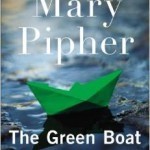 Mary Pipher, author, psychotherapist, and activist, spoke at the recent Future First Conference in Minneapolis, addressing the most dangerous defense the human race could adopt at this point, that of “willful ignorance”. According to Mary, willful ignorance occurs when we are caught between facing something too dreadful to acknowledge yet too dreadful to ignore.
Mary Pipher, author, psychotherapist, and activist, spoke at the recent Future First Conference in Minneapolis, addressing the most dangerous defense the human race could adopt at this point, that of “willful ignorance”. According to Mary, willful ignorance occurs when we are caught between facing something too dreadful to acknowledge yet too dreadful to ignore.
“Yet we cannot solve a problem we cannot face,” she asserted, and she continued to lace the hard facts of climate change and the political corruption supporting its denial, with anecdotal, funny stories, including influencing state legislators with apple pies (and not in the face, either!)
“We have a disordered relationship with the web of life,” she said. “We never get into the zone to work on issues.” She told of her own activism in forming a group in Nebraska to oppose the Keystone XL tar sands pipeline through their state, and particularly through the ecologically vulnerable Sandhills, actions which have successfully tied up the passage of the pipeline through the state for a few more years.
“Never ever allow yourself to get caught up in either/or,” she advised. “Move to a both/and.” She discussed how her group found common ground among people who have been manipulated to be polarized around issues that should not be politicized. We all want clean water. We do not want to be poisoned into perpetuity by spills or dumping of toxic chemicals. And many of us love the place we live. In finding this common ground, and not being divided by corporate interests and corruption, we can find ground to make positive change.
There were other gems to take away:
“If you are going to be an activist, you had better have fun!”
“Every emotion about climate change is the right emotion.”
“Once you face the truth about climate collapse, you can have a transcendent response: you grow bigger!”
“Acting as if we can change the situation is a healthy response.”
“Amazement antidotes despair.”
“We can grow and enhance our moral imaginations. Good increases moral imagination; evil decreases it.”
Her recent book, The Green Boat: Reviving Ourselves in Our Capsized Culture, describes her own path in dealing with what she calls planetary anguish, a book I found soothing and inspiring to read. The new normal of the new, unknown future will require we each find ways of dealing with planetary anguish over and over, and Mary Pipher’s story offers guideposts.
The post Mary Pipher’s Answer to “Willful Ignorance” appeared first on Patricia Damery.
November 12, 2014
Train Travel and Life

Donald dreaming.
Why do I love train travel so much? Every chance I get, I arrange “adventures” for family and friends that involve the rail, and they cheerfully oblige, at least the first time! Donald and I are traveling home from Minneapolis to Chicago, Chicago to Martinez, CA, now just beginning the climb after Denver into the Rockies. My iPhone says that it is 1º outside, a temperature that I always thought was too cold to snow, but it has been snowing heavily. We are warm, though, and sequestered in our super-roomette (okay, closet!)
People talk to each other on the trains; life slows down. There is time to write, to read, to sleep, to be curious about the rather amazing people riding on the train with us… a “pollinator experience”, I think. We talk over dinner with a steele worker from Reno, an activist from Stockton, a crazy artist from god-knows-where! Once we even dined with friends of one of Donald’s architectural professors from 60 years ago! We are seated with whomever shows up at the same time in the dining car. Amtrak calls it “community style”—we originally thought of it as a kind of enforced intimacy. But we have come to enjoy the socializing, which seldom happens on a plane.
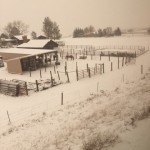
Passing a farm in Colorado on the climb into the Rockies.
Our dining room window looks out onto the sweeping landscape of our country, or, on the Empire Builder, the waves of the Mississippi as we followed it for miles along the Minnesota state line (what happens to the track when it floods?) We view backyards and marshes filled with cat tails, the gorge the Colorado has cut and the miles of corn and soybeans, while engaging in conversation with these people whom we would never know had we not been seated with them. And oddly, everyone is stripped of politics for a couple of days, it seems, wanting to be friendly and to get along—what if we all behaved this way more of the time? What if we all were more tolerant? The world would be different.
Time slows. Here it doesn’t matter if you are an hour late or three, if the freight trains have first dibs on the track. I wish I could transplant this feeling of spaciousness back into my everyday life.
Trains— passenger and rail—use far less energy per passenger than car or air travel: about half as much as cars and one third as much as air travel. Carbon emissions are lower. Train travel also offers a respite from the busy world. For a few days, we are on the lazy, rocking schedule of the train. And in a few days we will arrive home relaxed.
The post Train Travel and Life appeared first on Patricia Damery.
November 9, 2014
Joanna Macy and Sustaining the Gaze
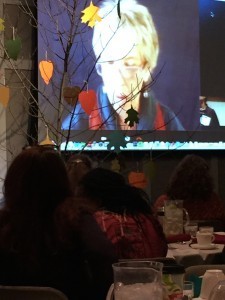
Joanna Macy meeting with us on Skype.
One of the many phrases that will stay with me from this week at Women’s Future First 2014 Congress is that of Joanna Macy: sustaining the gaze. Even though what we see in the world is frightening and enraging, it is so important we witness (not deny) what mankind has perpetrated upon our planet and to feel, to let ourselves have open hearts to Earth and her many inhabitants.
This conference is focusing on drafting a Bill of Rights for Water. Joanna addressed three practices that have consequences for water with results that last forever: nuclear power and its radiation contamination; genetically modified organisms, which cannot be undone once in use ; and fracking, which forever contaminates ground water with chemicals that cannot be extracted.
She “met” with us by Skype from her East Bay home and spoke with wit about these matters so important to our children, grandchildren, great grandchildren, our seven generations. Historically it is women who are the stewards of water, she reminded us. As we 450 women of all ages and great diversity, from all over the country, listened to this lively elder who has done so much to move people from despair and inaction to protectors and guardians of future generations, we were summoned. Women everywhere, and Men too, the time is here! The time for waking and action is now.
“It is a great privilege to be alive when the future ones want so much,” she said. She spoke of being willing– even glad!– to be living in a time with so much uncertainty.
And then Skype suddenly clicked off, and her image flashed away, as technology will do. There was no goodbye, only the lingering feeling in the room: here is an elder who sustained her gaze. She showed us it can be done, that, in fact, grief opens hearts, softens us, opens us to gratitude for the abundance of Earth and for each other. That what we do needs to be done out of love of the Earth, of each other, of our ancestral lineage, and of future generations.
You too can join this movement. My friend and colleague Leah Shelleda is attending the conference with me. Next weekend, November 15, Leah, Naomi Lowinsky, and I will be offering a writing seminar Wounded Earth, Wounded Psyche through the C. G. Jung Institute in San Francisco. Please join us. We have each other, most important in facing a crisis of this size, and writing helps heal and move us to action. We hope to see you there!
The post Joanna Macy and Sustaining the Gaze appeared first on Patricia Damery.
October 27, 2014
Jung, Steiner, and Evolution of Consciousness
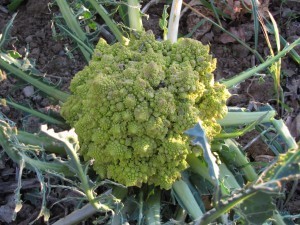
A living mystery
A recent seminar on Jung and Steiner and their contributions to an evolution of consciousness, held at the C. G. Jung Institute in San Francisco, was well attended by individuals schooled in both camps. This seems to be happening more and more: finding the common ground of these two men’s great works.
Although contemporaries, Carl Jung and Rudolf Steiner never met. And although they did not have much good to say about the other, they shared a common philosophical ancestor, Wolfgang von Goethe. (Rumor has it that Jung may have shared more than a philosophical lineage as his grandfather may have been an illegitimate offspring of Goethe’s!) Both men studied Goethe’s book length poem Faust as teenagers, Jung at the suggestion of his mother, and Steiner encouraged by a teacher who was editing Faust at the time. Goethe’s work presents an alternative approach to the natural world and the psyche, from the mechanistic way that has developed since Descartes. It reflects an approach that perceives the whole as a living substance, whether that be the human psyche or the flower growing along the roadside. Goethe developed techniques to communicate with the living substance of a plant, techniques which quiet the mind and require the use of imagination, love, and receptiveness.
Both Jung and Steiner developed their approaches based on this communication with the living substance, but for Jung, it was with the unconscious, and for Steiner, with the living Spirit, whether that be human or other spirits.
Is there a wisdom in these two men’s teachings being kept separate for the most part these 100 years? Steiner was esoteric, being fiery and airy; Jung sought refuge from judgment in “the scientific” and was more earthy. Is it possible these last years have afforded a development of these men’s ideas, and now we are in a time of purifying the good thinking of both men from the dogmatism that has also developed? Any philosophy is also a biography of a man’s soul. To the extent that this is true for analytical psychology (Jung) and anthroposophy (Steiner), perhaps we are in a time critical for a distillation of their works, purifying them of the impurities of personalities and the aberration of dogmatism that comes from followers.
Is the common ground of these men’s works a kind of feminine holding, of sorts, marrying an esoteric way of soul development back into a consciousness grounded in psychological development? To what end might this come? —dissolving back into the ethers fixed beliefs about our known disciplines and seeing what re-emerges? Will Goethe’s respectful approach to living substance, a guiding force in both men’s works, be a healing essence that remains?
The post Jung, Steiner, and Evolution of Consciousness appeared first on Patricia Damery.


